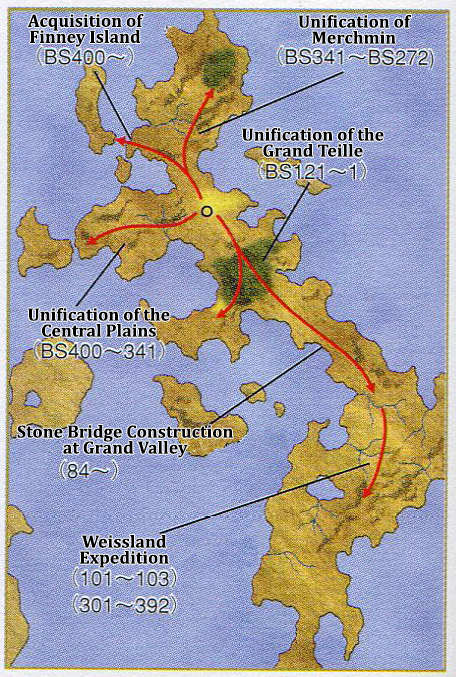♦ Founding of the Empire (400 BS 〜 Beginning of the Common Era) ♦
The Hahn Empire originated from a City-State in the central part of the Eastern Continent, located roughly 15 kilometers from the estuary of the Anath River. Though overlooking the river, the town was in a hilly area and not by any means prosperous.
Development of Hahn
400 BS
The City-State of Hahn suddenly rose to power around the year 400 BS thanks to the power of Quells. Before then, Quells were scarce in the Central Plains (around what is now Lordless Land) and it was impossible for the various countries to obtain them in large quantities. The situation changed around 370 BS, however, when the Independent City Alliance sent an expeditionary force to Merchmin and Finney Island. That was when feudal lords of Hahn found Quells buried underneath ruins discovered on Finney Island. Hahn seized control of the Central Plains and annexed Finney Island in 341 BS. Then the many Quells excavated from Finney Island were used to expand the power of Hahn.
Quells utilized in combat
300’s BS 〜
Quells certainly contributed to the sudden growth of Hahn. However, the most interesting point of note is how they were exclusively used to strengthen Hahn military forces. The first Quells discovered in Weissland were treated as mysterious ritual objects. This meant in theory that only the leaders of villages and tribes were able to utilize them for combat purposes. In Hahn, however, Quells were given to all commanding officers and military leaders.
This made it possible to carry out more complex strategies. The sheer number of Quells on hand and their high levels of power gave Hahn an overwhelming advantage in combat.
The results have been recorded in history. Certainly there were many strong Kingdoms in the Grand Teille which used Quells imported from Weissland. However, the Kingdom of Hahn continued to make rapid progress. The final battle with Laubholz in particular demonstrated how Quells were used to achieve a resounding victory for Hahn.
And a year after Laubholz fell, the Kingdom of Hahn declared itself an Empire.
♦ Rise and Fall of the Empire
(Beginning of the Common Era 〜 465) ♦
The founding of the Hahn Empire brought an era of prosperity. Maintaining the social infrastructure of the newly acquired lands increased domestic demands. Outfitting cities with the latest technology and servicing the roads linking them enriched the lives of the people and increased the wealth of the regions.
Weissland Expedition
101
While the infrastructure was being reworked, the Empire continued the construction of a stone bridge at Grand Valley, its completion coinciding with the 100th year of the Empire. This was in preparation for the planned southern expedition. The Empire already held control of the Grand Teille, but their true desire was to send military forces south to Weissland, where Quells were originally discovered. Another reason for the expedition was to obtain Quells which they believed could be unearthed in Weissland. And in the year 100, the first stone bridge was complete and the first expedition launched toward Weissland.
Imperial forces were able to march peacefully though Weissland, which had no countries of its own to oppose them. Many Quells were unearthed, making the expedition a success, and brought the most prosperous era of the Empire in terms of wealth and politics.
Discontent among the people and two rebellions
374
In the 300’s, the gap widened between those with Quells and those without and the aristocratic lifestyle became even more corrupt. Nobles stole from the people and found various ways to oppress them. Naturally the people rebelled and began forming anti-Imperial factions, but the nobles still held the upper hand thanks to the Quells in their possession.
While discontent grew among the people, two separate rebellions broke out. One was a rebellion of those imprisoned and forced to fight each other in the coliseum while the other was an uprising of those forced to work on construction of the stone bridge at Grand Valley.
The rebellion at the Imperial Capital was quelled in a matter of days. However, the rebellion at Grand Valley spread to nearby provinces and Imperial forces had to be dispatched to handle it. This was a major display of weakness for the Empire and signaled the end of its downfall.
Fall of the Empire
465
Many sensible people left for the Southern Continent as the Empire continued to weaken. Riots broke out everywhere that could not be suppressed and even the feudal lords began to distance themselves. Finally, in 445, the entire Grand Teille rose up in rebellion. The Empire was powerless to resist the sudden large-scale uprising and forced to evacuate and retreat. In 453, the Grand Teille forces finally reached the Imperial Capital. The countries of Merchmin at one point offered aid and refuge. But after the Merchmin region seceded from the Empire in 464, the Imperial Capital was yet again besieged. And in 465, after 3 days of chaos in the streets, the Empire fell.
